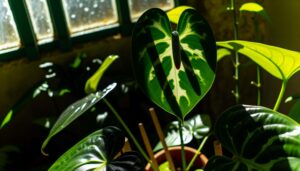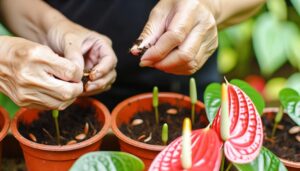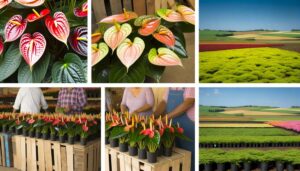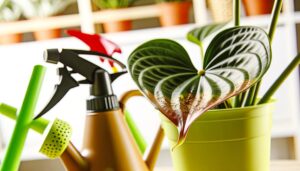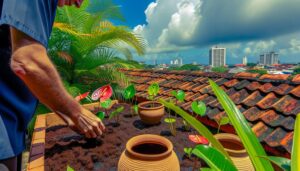Anthurium Pseudospectabile Care Guide – Everything You Need to Know
To care for Anthurium pseudospectabile, provide bright, indirect light to replicate rainforest conditions. Keep humidity between 70-80% and temperatures between 65-80°F.
Water when the top inch of soil is dry, using well-draining soil to prevent root rot. Fertilize biweekly with a balanced 20-20-20 N-P-K solution during the growing season.
Monitor for pests like spider mites and aphids, and treat promptly. Use sterilized tools for pruning and propagation, maintaining high humidity for root growth.
Position your plant near an east or north-facing window, and use a hygrometer to track humidity. Optimize these factors for robust growth and learn more techniques.
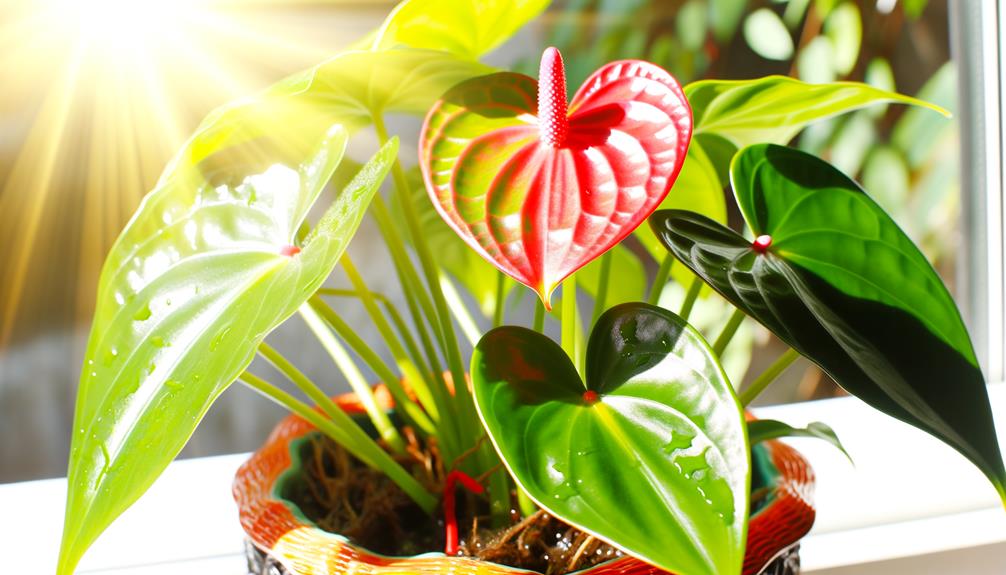
Key Takeaways
- Provide bright, indirect sunlight and avoid direct exposure to protect foliage.
- Water when the top inch of soil is dry, using well-draining soil to prevent root rot.
- Maintain ambient humidity between 70% and 80%, and keep temperatures between 65°F and 80°F.
- Fertilize biweekly with a balanced 20-20-20 N-P-K fertilizer during the growing season.
- Prune yellowing leaves and repot in a slightly larger container with well-draining soil for optimal growth.
Plant Origins
Anthurium pseudospectabile originates from the tropical rainforests of Central and South America, where it thrives in humid and shaded environments. You'll find this epiphytic plant clinging to tree trunks, utilizing its aerial roots to absorb moisture and nutrients from the surrounding air.
Its native habitat features constant high humidity and temperatures averaging between 70-85°F. This plant's morphology includes large, leathery leaves that can reach up to 30 inches in length, maximizing surface area for photosynthesis under the dense forest canopy.
Understanding its natural environment is essential for replicating these conditions in your home or greenhouse. It's important to mimic these parameters to ensure the plant's best growth and overall health.
Ideal Lighting
To replicate the dappled light conditions of its native rainforest, provide Anthurium pseudospectabile with bright, indirect sunlight, avoiding direct exposure that can scorch the foliage. Position the plant near an east or north-facing window where it can receive diffused light.
If natural light is insufficient, utilize full-spectrum fluorescent grow lights to simulate the plant's best photoperiod. Guarantee light intensity ranges between 10,000 to 20,000 lux for the most photosynthetic activity. Monitor leaf coloration; dark green leaves indicate insufficient light, while yellowing suggests overexposure.
A light meter can help maintain precise conditions, ensuring the plant thrives. Avoid placing the plant in low-light areas, as this can hinder growth and reduce its overall vigor.
Watering Needs
To maintain best hydration for Anthurium pseudospectabile, you should water it once the top inch of soil becomes dry, ensuring the substrate remains consistently moist but not waterlogged.
Signs of overwatering include yellowing leaves and root rot, indicating anaerobic soil conditions.
Employ well-draining soil to facilitate proper water retention and prevent water-related pathologies.
Optimal Watering Frequency
Maintaining the moisture level for Anthurium pseudospectabile involves watering when the top inch of soil feels dry to the touch, ensuring a balance between hydration and root aeration. Consistent monitoring is essential to prevent both water stress and root rot.
Employ these guidelines for best watering frequency:
- Soil Consistency: Utilize well-draining, aerated soil to facilitate proper moisture retention.
- Humidity: Maintain ambient humidity levels between 60-80% to replicate its natural tropical habitat.
- Temperature: Water more frequently in warmer conditions, while reducing frequency in cooler environments.
- Seasonal Adjustments: Increase watering during active growth periods (spring and summer) and decrease during dormancy (fall and winter).
- Container Choice: Use pots with drainage holes to avoid waterlogging.
Signs of Overwatering
Overwatering manifests through symptoms such as yellowing leaves, mushy stems, and a musty scent emanating from the soil. When waterlogged, the root system becomes deprived of essential oxygen, leading to root decay caused by anaerobic bacteria and fungi.
You'll notice chlorosis, where the leaves turn yellow due to impaired chlorophyll production. Stems may feel soft and exhibit necrosis, indicating cell death. The soil often smells musty due to microbial activity and decay.
To assess overwatering, check the substrate's moisture level and drainage efficiency. Make sure your Anthurium Pseudospectabile is in a well-draining potting mix and adjust watering frequency accordingly. Implementing these measures will reduce overwatering effects and promote healthier growth.
Humidity Levels
To sustain Anthurium pseudospectabile's peak health, you should maintain ambient humidity levels between 70% and 80%.
Utilize a hygrometer for precise monitoring and consider employing a humidifier to enhance moisture levels if needed.
Regular misting and placing the plant on a humidity tray can also improve the microenvironment's relative humidity.
Optimal Humidity Range
Achieving the perfect humidity range, typically between 70% and 80%, is crucial for the thriving growth of Anthurium pseudospectabile. This tropical epiphyte demands a consistently humid environment to maintain cellular turgor pressure, ensuring robust foliage and ideal physiological functions.
To maintain this humidity level, you should monitor and adjust ambient conditions regularly.
- Hygrometer Utilization: Employ a hygrometer to measure real-time humidity levels.
- Humidity Trays: Place shallow trays filled with water and pebbles beneath the plant.
- Humidifiers: Use an ultrasonic humidifier to emit fine mist.
- Regular Misting: Mist leaves with demineralized water to simulate natural humidity.
- Environmental Adjustment: Position plants in naturally humid areas like bathrooms or kitchens.
Understanding these factors will enhance your Anthurium's vibrancy.
Increasing Moisture Levels
Maintaining high moisture levels around Anthurium pseudospectabile involves strategic interventions like employing humidity trays and regular misting to replicate its native tropical habitat.
You can use a humidity tray by placing a shallow dish filled with water and pebbles under the plant's pot, ensuring the pot doesn't sit directly in water but benefits from evaporative moisture.
Regular misting with dechlorinated water helps increase the ambient humidity but avoid over-wetting the foliage to prevent fungal growth.
Consider using a hygrometer to monitor humidity levels, aiming for a relative humidity of 60-80%.
Additionally, placing your plant in a room with a humidifier can provide a consistent moisture environment.
Temperature Range
Maintaining an ideal temperature range for Anthurium Pseudospectabile involves keeping a consistent environment between 65°F and 80°F (18°C to 27°C) to promote healthy growth. This species thrives in controlled conditions where temperature fluctuations are minimized.
Key temperature considerations include:
- Regular Monitoring: Use a dependable thermometer to frequently check ambient temperature.
- Avoiding Drafts: Place the plant away from windows or doors that might introduce cold drafts.
- Humidity Control: Higher temperatures often require increased humidity; consider a humidifier.
- Night vs. Day: Maintain a slight temperature drop at night to mimic natural conditions.
- Heat Sources: Avoid placing near direct heat sources like radiators, which can cause temperature spikes.
These measures will help your Anthurium Pseudospectabile remain in top-notch health.
Soil Requirements
For best growth, Anthurium Pseudospectabile requires a well-draining soil mix rich in organic material and capable of maintaining moisture without getting saturated. You'll want to achieve an optimal combination by blending orchid bark, perlite, and sphagnum peat moss. This mixture ensures excellent aeration, crucial for root respiration, and retains sufficient moisture without risking root rot.
Integrate charcoal to improve drainage and reduce fungal growth. Aim for a slightly acidic to neutral pH, ideally around 5.5 to 6.5. Regularly check soil porosity to prevent compaction, which can hinder proper water flow and oxygen exchange.
Fertilization Tips
When fertilizing Anthurium Pseudospectabile, you should use a balanced, water-soluble fertilizer with an N-P-K ratio of 20-20-20. Apply the fertilizer biweekly during the growing season to guarantee ideal nutrient uptake and robust growth.
It's important to reduce feeding frequency to once a month during dormancy to prevent nutrient overload and root burn.
Ideal Fertilizer Types
To optimize the growth of Anthurium pseudospectabile, employ a balanced, water-soluble fertilizer with a 20-20-20 NPK ratio, applied biweekly during the growing season. This fertilizer guarantees an even distribution of nitrogen, phosphorus, and potassium, essential for robust foliage, root development, and overall plant health.
- Micronutrients: Look for fertilizers that include vital micronutrients like magnesium, iron, and manganese.
- Chelated Nutrients: Choose formulations with chelated nutrients for better absorption.
- pH Compatibility: Ensure the fertilizer maintains a slightly acidic to neutral pH (5.5-6.5).
- Organic Options: Consider organic fertilizers with slow-release properties to prevent nutrient burn.
- Dissolution: Guarantee the fertilizer dissolves completely in water to avoid soil aggregation issues.
These guidelines will help maximize your Anthurium's growth potential.
Optimal Feeding Schedule
A careful feeding schedule is crucial for Anthurium pseudospectabile, ensuring the plant receives consistent nutrient supply throughout its growth cycle.
Administer a balanced, water-soluble fertilizer with an N-P-K ratio of 20-20-20, diluted to half strength, every four weeks during the active growing season (spring to early autumn).
Reduce feeding to every eight weeks during the dormant period (late autumn to winter).
Monitor for signs of nutrient deficiency, such as chlorosis or stunted growth, and adjust the frequency accordingly.
Implement foliar feeding by spraying a diluted fertilizer solution directly onto leaves once a month. This approach promotes rapid nutrient uptake.
Regular flushing of the soil with water helps prevent salt buildup, maintaining ideal root health.
Pruning Guidelines
Proper trimming of Anthurium pseudospectabile involves strategically removing dead or damaged leaves to promote healthy growth and prevent disease. You'll need sterilized trimming shears to avoid introducing pathogens. Focus on cutting close to the base without harming the main stem. This plant benefits from trimming during its active growth phase.
- Identify necrotic tissue: Look for brown or yellowing leaves.
- Sterilize tools: Use isopropyl alcohol to clean blades.
- Cut at an angle: Make sure cuts are slanted to prevent water accumulation.
- Remove spent blooms: Trim faded flowers to encourage new growth.
- Inspect regularly: Monthly checks help maintain plant health.
Repotting Advice
After ensuring your Anthurium pseudospectabile is well-pruned, it's important to understand the specifics of repotting to support its root health and overall growth.
Choose a container that's 2-3 inches larger in diameter than the current one to provide ample space for root expansion. Utilize a well-draining potting mix, ideally a combination of orchid bark, peat moss, and perlite, to mimic its natural epiphytic environment.
Gently remove the plant from its existing pot, taking care not to damage the roots. Inspect for root rot or damage and trim any affected areas. Place the plant in the new container, backfilling with the prepared substrate, ensuring the roots are securely covered.
Water thoroughly to settle the soil and eliminate air pockets.
Pest Management
Monitoring for pests is crucial for maintaining the health of your Anthurium pseudospectabile, as common culprits like spider mites, aphids, and mealybugs can cause significant damage if left unchecked. Regular inspection and prompt action are critical. Examine the undersides of leaves and stems for signs of infestation. Early detection allows for non-invasive treatments such as insecticidal soap or neem oil.
- Spider mites: Look for tiny, yellow stippling or webbing.
- Aphids: Identify clusters of small, soft-bodied insects.
- Mealybugs: Notice cotton-like masses on stems and leaves.
- Thrips: Detect elongated insects causing silvery streaks.
- Scale insects: Observe hard, shell-like bumps.
Implement biological controls like predatory insects to enhance pest management. Consistent vigilance guarantees your Anthurium thrives.
Common Diseases
In addition to pests, your Anthurium pseudospectabile is also susceptible to a range of common diseases that can impede its growth and health. Bacterial blight, caused by Xanthomonas spp., leads to water-soaked lesions and yellowing foliage. Fungal infections like root rot, often due to Phytophthora spp., cause root necrosis and stunted growth.
Powdery mildew, a fungal pathogen, manifests as a white, powdery film on leaves, restricting photosynthesis. Viral diseases, such as mosaic virus, exhibit mottled or distorted leaves, diminishing plant vigor.
To mitigate these issues, maintain ideal humidity levels, ensure proper drainage, and practice good sanitation. Regularly inspect your plant, and promptly remove any affected parts to prevent disease spread. Use fungicides or bactericides when necessary for effective disease management.
Propagation Methods
Propagating Anthurium pseudospectabile can be effectively achieved through stem cuttings or division, both requiring careful attention to maintain the plant's health and vigor.
For stem cuttings, make sure you select a healthy segment with at least one node and aerial roots. Use a sharp, sterilized knife to make clean incisions to prevent pathogen entry.
For division, gently separate the root ball making sure each section has sufficient roots and foliage.
- Sterilize tools to prevent infections.
- Use rooting hormone to enhance root development in cuttings.
- Maintain high humidity for best root growth.
- Provide indirect light to avoid stressing the new plants.
- Keep consistent moisture in the growing medium.
These methods will lead to successful propagation and strong plant growth.
Conclusion
In wrapping up your journey with Anthurium pseudospectabile, remember, it thrives under dappled sunlight, with soil that's consistently moist but never waterlogged.
Keep the humidity high and temperatures warm, like a tropical embrace. Repot when roots outgrow their home, and watch for pests and diseases like a vigilant gardener.
Propagate with care, and you'll cultivate a botanical masterpiece, thriving and vibrant. Your dedication will yield a flourishing green marvel, a proof of your horticultural prowess.

